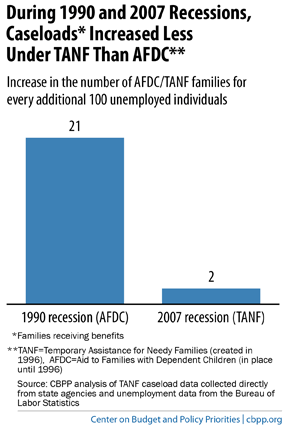BEYOND THE NUMBERS
Data Show TANF Didn’t Respond Adequately to Need During Recession, Contrary to New Study’s Claims
A recent study from researchers at the Brookings Institution and the University of Nevada concludes that the Temporary Assistance for Needy Families (TANF) program responded to increased need during the Great Recession in the majority of states as a good safety net program would. This conclusion, however, is based on seriously flawed analysis, as we explain in a new paper.
A number of assertions made by the authors — Ron Haskins and Kimberly Howard of the Brookings Institution and Vicky Albert of the University of Nevada — wilt under scrutiny. Consider, for example, one such claim: that TANF responded to a greater degree in the 2000 and 2007 recessions than the Aid to Families with Dependent Children program (AFDC), TANF’s predecessor, did in previous recessions. But this claim rests on inappropriate use of data.
The authors arrive at this conclusion by averaging the percentage increase (or decrease) in the AFDC “caseload” (families who received benefits) during the 1980, 1981, and 1990 recessions and comparing that to the average percentage change in the TANF caseload during the 2000 and 2007 recessions. This metric produces highly skewed results, however.
The AFDC caseload at the start of all three of the early recessions was much larger than the TANF caseload at the start of the 2000 and 2007 recessions, making a percentage-change comparison highly misleading. From the beginning to the end of the 1990 recession, the number of unemployed individuals rose by 1.7 million, while the AFDC caseload increased by 350,000 families. From the beginning to the end of the 2007 recession, the number of unemployed individuals rose by 7 million, while the TANF caseload increased by just 124,000 families.

We’ve monitored TANF carefully since the start of the recession and have a far less sanguine assessment of the program’s responsiveness to the recent recession than Haskins, Howard, and Albert do. We conclude that the program fell well short of how we would expect such a basic safety net program to respond during tough economic times.
In spite of its shortcomings, TANF is often held up as a model for altering other safety net programs. The Haskins, Howard, and Albert study is likely to be cited as evidence that TANF performs fine in recessions, so other programs (such as SNAP) can be changed to a similar block-grant structure. But that would be a highly inappropriate conclusion based on flawed use of data.
